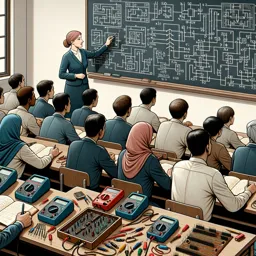
Free online courseIntermediate electronics
Duration of the online course: 3 hours and 22 minutes
Enhance your skills with CircuitBread's Intermediate Electronics course. Explore molecular-level diode operations, microcontroller basics, MOSFETs, and more through detailed animations and practical examples.
In this free course, learn about
- Semiconductors and Diodes Fundamentals
- PN Junctions and Basic Diode Behavior
- Microcontroller Basics with PIC10F200
- Programming the PIC10F200 in Assembly
- Advanced PIC10F200 Applications
- Interactive Projects with PIC10F200
- Transistors and Diode Regulation Concepts
- Semiconductor Types and Practical Zener Regulation
- MOSFET Operation and Regions
- Signal Shaping with Diodes and BJT Regions
Course Description
The "Intermediate Electronics" course offers a comprehensive exploration into the intricate world of electronic components and systems. With a total duration of 3 hours and 22 minutes, this professional-level course is tailored specifically for electricians seeking to deepen their understanding of electronic principles and applications. Garnering an impressive average rating of 5 stars, this course has been highly praised by learners for its depth, clarity, and engaging content.
Designed for those who have some foundational knowledge in electronics, the course delves into the complex mechanisms of diodes, exploring both forward and reverse biased states at a molecular level. Through detailed animations, learners can visualize how semiconductors operate, enriching their comprehension of electronic theory. The course also covers the operational principles of LEDs, explaining the interplay between molecular structures and practical implementations.
In addition to passive components, the course introduces microcontrollers, with a focus on the PIC10F200 series. Learners are guided through a step-by-step process, from basic introduction to more complex applications including microcontroller architecture, software setup with MPLAB X IDE, and assembly programming. Practical exercises such as blinking an LED, creating a PWM, and generating music with assembly language provide hands-on experience that solidifies theoretical knowledge.
The course further covers the concept of Zener diodes and their applications, such as voltage regulation. There's also a segment dedicated to creating and managing DIY Christmas lights using microcontroller-mediated Charlieplexing LEDs, offering a festive twist to practical learning. Advanced topics, including the functioning and classification of semiconductors, variable capacitor diodes, and bipolar junction transistors (BJTs), are explored through animations and practical demonstrations.
For those interested in power supply design, the course presents considerations for employing half-wave rectifiers. Detailed comparisons between NMOS and PMOS, as well as enhancement and depletion mode MOSFETs, equip learners with the knowledge to differentiate and apply these crucial components effectively. The course concludes with an insightful look into UARTs, from theoretical principles to practical implementation in software, enhancing communication protocols within electronic systems.
Overall, "Intermediate Electronics" is a meticulously curated course that bridges the gap between basic and advanced electronic concepts, enriched with animated explanations and practical projects to foster both understanding and application in real-world scenarios.
Course content
- Video class: How does a forward biased diode work at the molecular level? - Part 2 | Intermediate Electronics 05m
- Exercise: _What is the requirement for forward-biasing a diode?
- Video class: Band Gap and Semiconductor Current Carriers | Intermediate Electronics 04m
- Exercise: _What is the difference between the band gap of an insulator and a semiconductor?
- Video class: How do semiconductors work? (with animation) | Intermediate Electronics 04m
- Exercise: _What is the most commonly used semiconductor material in the electronics industry?
- Video class: How does a diode work - the PN Junction (with animation) | Intermediate Electronics 05m
- Exercise: _What is the majority carrier in the p region of a pn junction?
- Video class: How does a reverse biased diode work at the molecular level? - Part 3 | Intermediate Electronics 03m
- Exercise: _What happens to the depletion region when a diode is placed in reverse bias?
- Video class: How does an LED work at the molecular AND practical level? | Intermediate Electronics 04m
- Exercise: _What makes an LED different from a regular diode?
- Video class: How to Use a Simple Microcontroller Part 1 - An Introduction (PIC10F200) 06m
- Exercise: _What is the reason for using the microchip PIC10F200 in the Simple Microcontroller Series?
- Video class: How to Use a Simple Microcontroller (PIC10F200) Part 2 - Equipment Needed 04m
- Exercise: _What is the recommended way to purchase a PIC10F200 microcontroller?
- Video class: Microcontroller Architecture - Part 3 Simple Microcontroller (PIC10F200) | Intermediate Electronics 08m
- Exercise: _How many instructions can be put in and actually used in the PIC10F200 microcontroller?
- Video class: Getting Started with MPLAB X IDE - Part 4 Microcontroller Basics (PIC10F200) 06m
- Exercise: _What is the purpose of the resistors connected to Switch 1 and Switch 2 in the circuit setup?
- Video class: Your First Assembly Program - Part 5 Microcontroller Basics (PIC10F200) 14m
- Exercise: _What is the purpose of labels in assembly language?
- Video class: How to Blink an LED - Part 6 Microcontroller Basics (PIC10F200) 10m
- Exercise: What is the primary purpose of using delay loops in this assembly program?
- Video class: Creating a PWM in Assembly - Part 7 Microcontroller Basics (PIC10F200) 09m
- Exercise: _What is the purpose of the "i EQU 10" and "limit EQU 11" commands in the program?
- Video class: What is a zener diode and how does it work? | Intermediate Electronics 03m
- Exercise: _What is a Zener diode and how is it different from a typical diode?
- Video class: DIY Christmas Lights with a Microcontroller - Charlieplexing LEDs (PIC10F200) | Christmas Special 08m
- Exercise: _What is charlieplexing and how many LEDs can be controlled with three GPIO pins on the PIC10F200 microcontroller?
- Video class: Creating music with Assembly - Part 8 Microcontroller Basics (PIC10F200) 09m
- Exercise: _What is the purpose of the tutorial with the PIC10F200 microcontroller?
- Video class: Using buttons with your microcontroller in Assembly - Part 9 Microcontroller Basics (PIC10F200) 13m
- Exercise: _What is the purpose of the buttons in this tutorial?
- Video class: What is a variable capacitor diode – how does it work? | Intermediate Electronics 05m
- Exercise: _What is the formula for capacitance in a capacitor and varicap diode?
- Video class: Animated BJT – How a Bipolar Junction Transistor works | Intermediate Electronics 04m
- Exercise: _What are the two basic types of transistors?
- Video class: Zener Diode Conceptual Overview | Intermediate Electronics 04m
- Exercise: _What is the purpose of a voltage regulator?
- Video class: What to Consider when Designing a Power Supply with a Half Wave Rectifier | Intermediate Electronics 07m
- Exercise: _What is the purpose of a rectifier in a DC power supply?
- Video class: Classification of Semiconductors (Intrinsic/Extrinsic, P-Type/N-Type) 05m
- Exercise: _What is the most commonly used semiconductor material in the electronics industry?
- Exercise: _What is the most commonly used semiconductor material in the electronics industry?
- Video class: Practical example of Zener Diode as a Voltage Regulator | Intermediate Electronics 08m
- Exercise: _What are the four variables that need to be considered when using a Zener diode as a voltage regulator in real life?
- Video class: How a MOSFET Works - with animation! | Intermediate Electronics 04m
- Exercise: _What is the meaning of MOSFET?
- Video class: NMOS vs PMOS and Enhancement vs Depletion Mode MOSFETs | Intermediate Electronics 03m
- Exercise: _What is the main difference between an enhancement mode MOSFET and a depletion mode MOSFET?
- Video class: What are the Different Regions of Operation for a FET? | Intermediate Electronics 04m
- Exercise: _What is the region of operation where the current is saturated and cannot get any bigger in a MOSFET?
- Video class: How a UART works and how to make one in software - Part 11 Microcontroller Basics (PIC10F200) 15m
- Exercise: _What is the difference between UART and RS 232 communication protocols?
- Video class: Using Diodes as Clippers or Clampers | Intermediate Electronics 09m
- Exercise: _What is the difference between a negative series clipper and a positive series clipper?
- Video class: Different Operating Regions of Bipolar Junction Transistors (BJTs) | Intermediate Electronics 07m
This free course includes:
3 hours and 22 minutes of online video course
Digital certificate of course completion (Free)
Exercises to train your knowledge
100% free, from content to certificate
Ready to get started?Download the app and get started today.
Install the app now
to access the courseOver 5,000 free courses
Programming, English, Digital Marketing and much more! Learn whatever you want, for free.
Study plan with AI
Our app's Artificial Intelligence can create a study schedule for the course you choose.
From zero to professional success
Improve your resume with our free Certificate and then use our Artificial Intelligence to find your dream job.
You can also use the QR Code or the links below.

More free courses at Electrician

Free CourseEngineering Circuits Analysis

3h11m

20 exercises

Free CourseSiemens PLC Training

9h42m

32 exercises

Free CourseElectronic Circuits Course

43h25m

49 exercises

Free CourseElectronic Circuit Design Course

9h31m

51 exercises

Free CourseElectronics - Nanoelectronics: Devices and Materials

40h15m

31 exercises

Free CourseElectricity course

31h41m

6 exercises

Free CourseBeginner Electronics

5h27m

24 exercises

Free CourseElectrical - Fabrication of Silicon

35h10m

28 exercises

Free CourseBasic electronics

6h04m

30 exercises

Free CourseElectrical engineering

11h53m

20 exercises

Free CourseEngineering Circuits Analysis
3h11m
20 exercises

Free CourseSiemens PLC Training
9h42m
32 exercises

Free CourseElectronic Circuits Course
43h25m
49 exercises

Free CourseElectronic Circuit Design Course
9h31m
51 exercises

Free CourseElectronics - Nanoelectronics: Devices and Materials
40h15m
31 exercises

Free CourseElectricity course
31h41m
6 exercises

Free CourseBeginner Electronics
5h27m
24 exercises
Free CourseElectrical - Fabrication of Silicon
35h10m
28 exercises

Free CourseBasic electronics
6h04m
30 exercises

Free CourseElectrical engineering
11h53m
20 exercises
Free Ebook + Audiobooks! Learn by listening or reading!
Download the App now to have access to + 5000 free courses, exercises, certificates and lots of content without paying anything!
-
100% free online courses from start to finish
Thousands of online courses in video, ebooks and audiobooks.
-
More than 60 thousand free exercises
To test your knowledge during online courses
-
Valid free Digital Certificate with QR Code
Generated directly from your cell phone's photo gallery and sent to your email

Download our app via QR Code or the links below::.






